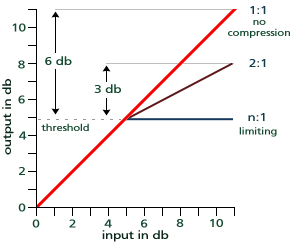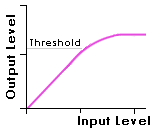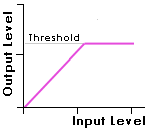| Compressors |
| A process for altering the dynamic envelope of an audio signal. Compressor/Limiters
are dynamics processing devices which reduce the gain of an incoming signal
by some user specified compression ratio. The processing is caused when
the level of the signal exceeds a user specified threshold. Common
Controls: threshold: the level past which compression or limiting will
begin to take effect, ratio: the amount of gain reduction which takes effect
after the threshold is exceeded, if a 2:1 ratio is selected, a 3 dB increase
in the level of the input signal will be reduced to 1.5 dB at the output.
Lower gain reduction ratios, (1.5:1 to 4:1) are known as compression and
are useful for smoothing out the dynamic range of a signal and increasing
apparent loudness, and sustain. Higher ratios are known as limiting because
the gain reduction begins to take effect more suddenly after the threshold
is exceeded. Useful for protecting amplifiers, speakers, and radio signal
modulators from overloading. Attack: how fast the gain is reduced in response
to an increase in input signal level above the threshold - too fast results
in unnatural fluctuations in the signal dynamic, and distortion of low
frequency signals as the compressor attempts to "ride" the wave form -
too slow lets the high level signal through before the compressor has time
to react. Faster times are useful in limiting applications, slower
times are useful in compression applications. Release: how fast the gain
is restored to normal levels after the input signal falls below the threshold
- too fast and the output signal is "choppy" or "jittery" as the gain is
changed rapidly - too slow results in unwanted lowering of the gain of
low level portions of the signal due to sluggishness of response balance
between fast (potential "pumping" or "breathing") and slow unwanted ducking
after a high level portion of signal. Bypass: useful for comparing the
unaffected signal to the effected. Stereo linking: useful in processing
a stereo signal, two channels can be linked together so that the threshold
and gain control settings of only one of the channels controls both compressors,
this avoids shifting of the stereo image.
Metering: gives an indication, usually in dB, of the amount of instantaneous gain reduction being applied to the input signal - allows comparisons of the signal level at the input and after dynamic processing at the output. |
| Compressor/Limiters
are dynamics processing devices which reduce the gain of an incoming signal
by some user specified compression ratio.
The processing is caused when the level of the signal exceeds a user specified threshold. |
| The
diagram to the right shows a signal compressed with
a 2:1 ratio which begins acting when the signal level exceeds 9 dB.
At a
2:1 ratio gain is reduced by one decibel for each
two above the threshold.
|
 In the
case of very large compression ratios approaching
infinity the compressor acts as a limiter, clamping the input signal level
to the threshold.
In the
case of very large compression ratios approaching
infinity the compressor acts as a limiter, clamping the input signal level
to the threshold. |
|
|
| Signal Detection: |
|
| The first thing a compressor needs to do is detect a signal and determine its gain in relation to the threshold setting. There are several different signal detection techniques used: |
| rms |
| This technique calculates the rms or root-mean-square
of the signal (the square root of the average of the squares of a variable
signal). A somewhat complex calculation, it slows down the response time
of the compressor making it susceptible to peak distortion for signals
with high level transients.
The benefits of rms detection are is similarity to the response characteristics of the human ear and a resulting more "natural" sound with less of the "pumping" effects which can plague a faster detection scheme |
| averaging |
| With this detection scheme the signal is simply averaged. This is technically easy to do and gives similar results to rms detection but not as close to the response characteristics of human hearing |
| peak |
| The peak detection scheme simply looks at the instantaneous level of the incoming signal and bases its processing on that level. This makes peak detection the fastest and most responsive of detection schemes, a particularly good feature for limiting applications where you wish to avoid brief transients passing through. The effect of the compressor ducking signal peaks so quickly may cause an unnatural audible "pumping" effect as the gain of the signal is adjusted very quickly and frequently. |
| Compression Types: |
|
| softknee | hardknee |
 |
 |
| softknee applies a scurve at the threshold point to soften compression onset. This smoother application retains more instrumental dynamics | hardknee or no softening at threshold point applies full compression ratio immediately. This useful for limiting applications designed to avoid clipping. |
| Other Common Controls |
|
| threshold |
| the level past which compression or limiting will begin to take effect |
| ratio |
| the amount of gain reduction which takes effect after the threshold
is exceeded, if a 2:1 ratio is selected, a 3 db increase in the level of
the input signal will be reduced to 1.5 db at the output lower gain reduction
ratios 1.5:1 to 4:1 are known as compression and are useful for smoothing
out the dynamic range of a signal and increasing apparent loudness, and
sustain
higher ratios are known as limiting because the gain reduction begins to take effect more suddenly after the threshold is exceeded. useful for protecting amplifiers, speakers, and radio signal modulators from overloading. |
| attack |
| how fast the gain is reduced in response to an increase in input signal level above the threshold too fast results in unnatural fluctuations in the signal dynamic, and distortion of low frequency signals as the compressor attemps to "ride" the waveform too slow lets the high level signal through before the compressor has time to react faster times are useful in limiting applications slower times are useful in compression applications. |
| release |
| how fast the gain is restored to normal levels after the input signal falls below the threshold too fast and the output signal is "choppy" or "jittery" as the gain is changed rapidly input/output monitoring too slow results in unwanted lowering of the gain of low level portions of the signal due to sluggishness of response balance between fast (potential "pumping" or "breathing") and slow unwanted ducking after a high level portion of signal |
| bypass |
| useful for comparing the uneffected signal to the effected |
| stereo linking |
| useful in processing a stereo signal, two channels can be linked together so that the threshold and gain control settings of only one of the channels controls both compressors, this avoids shifting of the stereo image |
| Metering |
|
| gain reduction |
| gives an indication, usually in db, of the amount of instantaneous gain reduction being applied to the input signal |
| input/output |
| allows comparisons of the signal level at the input and after dynamic processing at the output |
| Sidechain Control |
|
| amplitude dependent |
| ducking |
| frequency dependent |
| insert an equalizer in the sidechain set for boost at the frequencies that need gain control de-essing, set eq for high frequency boost to force the compressor to limit sibilance |
| time delays |
| delay the source signal and feed the undelayed signal to the compressor and mix for "backwards tape" effects. |
| Caveats |
|
| too high ratio |
| noise floor becomes audible, particularly with an inherently noisy
source
"squeezed" unnatural sound |
| too short attack/release times |
| "choppy" or "jittery" sound, particularly with low frequency sounds
"pumping" or "breathing" are the effects of excessively short attack or release times and areparticularly noticeable with noisy signals as the noise floor is audibly brought up and down with the gain adjustments |